Recent Viewing: horror from Arrow Video
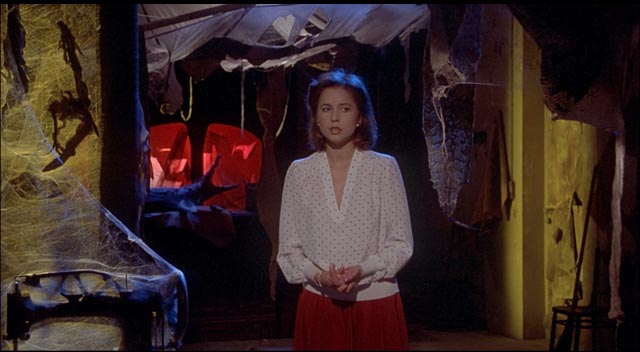
Winter, even this one which has turned out to be so much less brutal than last year’s, is pretty depressing. Rising in darkness and heading off on a one-hour commute to work before the sun rises; arriving home again as the sun is close to setting; having to wear a heavy coat and boots; most of all barely seeing daylight for several months … living in a place like Winnipeg is virtually guaranteed to produce seasonal affective disorder. Maybe that’s why I’ve been indulging in quite a bit of horror viewing since New Year.
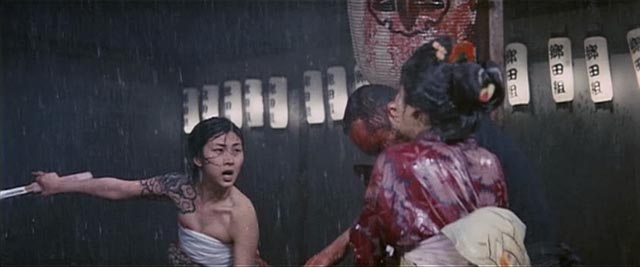
Blind Woman’s Curse (Teruo Ishii, 1970)
I recently binged on a stack of Blu-rays from Arrow Video in England, starting with Teruo Ishii’s Blind Woman’s Curse, an odd hybrid produced by Nikkatsu in 1970. Ishii was a prolific director of genre films whose career spanned more than four decades. I confess that I’ve seen little of his work, but it’s quite apparent that he had a gleeful penchant for the grotesque, basing a number of movies on works by Edogawa Rampo – including his final film, Blind Beast vs Killer Dwarf (2001), a kind of sequel to Yasuzo Masumura’s perverse Blind Beast (1969). Of the films I’ve seen the best is Horrors of Malformed Men (1969), a Rampo story which stands as a kind of oneiric anti-Moreau, about a mad doctor who turns human beings into beasts.
Blind Woman’s Curse is a far less polished work, a deranged mash-up of yakuza and ghost story tropes. The core of the story is the conflict between the Tachibana gang led by Akemi (Meiko Kaji) and a rival gang. During a visually striking battle in the rain which serves as the opening credit sequence, Akemi inadvertently blinds Aiko (Hoki Tokuda), the daughter of the rival gang’s leader. The consequences of this action were complicated at the insistence of Nikkatsu by the introduction of a traditional “ghost cat” element, with the sinister animal popping up at odd moments as an omen of Akemi’s guilt and a sign of the fate that awaits her. Ishii himself quite openly admitted that the film is incoherent, but rather than letting that get in the way, he fills it with layer upon layer of absurdity. The period is unspecified, mixing the present and past for no particular reason, adding a third gang led by Aozora (Ryohei Uchida), a strange joker character who wears a loincloth and bowler hat and gets in the way of the two main gangs as they try to fight each other. By the end, the climactic showdown between Akemi and Aiko takes place on a completely stylized set with a painted sky full of swirling colours. All the craziness serves chiefly as an excuse for inventive visuals and the heated rivalry of the two women, with both actresses seizing the opportunity enthusiastically. I wouldn’t call Blind Woman’s Curse a good film, but it’s certainly entertaining.
The disk features a commentary by critic Jasper Sharp and a booklet essay by Japanese cinema authority Tom Mes which situates Ishii’s work in the specific artistic tradition of the erotic grotesque.
*
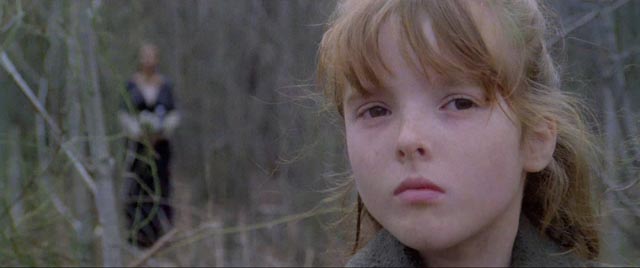
The House By the Cemetery (Lucio Fulci, 1981)
Italian directors of horror are no more strangers to absurdity and narrative illogic than their Japanese counterparts and Lucio Fulci at his best captures a similar dreamlike effect perhaps more than most; things happen without any clear point, disturbing images of madness and violence barely hanging together on the thinnest of narrative threads. At his best, Fulci achieves an oneiric atmosphere which borders on pulp poetry; at his less-than-best, his work can seem clumsy and irritating.
Like many of his fellow directors from the ’60s and ’70s, he worked in numerous genres – sex comedies, costume drama, thrillers, westerns, gialli – before he really hit his stride in 1979 with a quick attempt to cash in on the success of George Romero’s Dawn of the Dead. Zombie was a huge hit, and in the following two years Fulci made four more horror films which stand as his best work: City of the Living Dead, The Black Cat, The Beyond (arguably his masterpiece) and The House By the Cemetery, after which like much of the Italian film industry he struggled with shrinking budgets and diminishing returns through a series of increasingly shoddy projects.
The House By the Cemetery is smaller in scale than Zombie, City of the Living Dead and The Beyond, but in some ways is one of Fulci’s most controlled works – which is not to say that it’s coherent. Most of it takes place in a remote house somewhere in New England (exteriors shot in and around Concord, Massachusetts; the rest on soundstages in Rome) where an academic (Paolo Malco) has gone to sort through the papers of a former colleague who may have committed suicide; he takes along his wife Lucy (Catriona MacColl, in the last of three films she made with Fulci) and their son Bob (Giovanni Frezza, rather creepy thanks in part to the ill-matched voice he’s dubbed with). Needless to say, the house has a bad reputation stemming from events in the past which are tied in with the contents of the dead man’s research. Bob meets and befriends Mae (Silvia Collatina), a young girl who may be a ghost, who warns him not to stay at the house; Ann (Ania Pieroni), a babysitter/helper, is somewhat disturbing; and there’s something living below the house which has a penchant for killing people who come within reach.
In structure, the story is a series of repetitive scenes of tension and menace, with the husband seeming to be taken possession by his work, Lucy feeling threatened, and various people getting killed. The revelation of the basement dweller’s identity is hardly a surprise, though he’s given an effectively disturbing look by makeup artist Giannetto De Rossi. The film’s distinctive mood comes from Fulci’s willful avoidance of logic. After one killing leaves a huge pool of blood on the kitchen floor, Lucy comes down in the morning while Ann is mopping it up with a rag. They have a conversation during which neither mentions the blood and, indeed, Lucy doesn’t even seem to see it. This kind of thing can be distracting to a viewer as the content of the scene (the dialogue) is pushed aside by wondering when the heck the blood is going to be mentioned.
Is this simply clumsy staging? MacColl mentions in an interview in the accompanying booklet that whenever anyone would question this kind of thing Fulci would just say “it’s in the script, do it”. (In her commentary, she makes a half-hearted attempt to explain it away by saying that perhaps Ana had cleaned it up by then so Lucy didn’t notice it, although it’s still very apparent to the audience.) One of Fulci’s frequent quirks is to have characters who are being menaced simply stand there, not reacting (as with some of the attacks by the undead in Zombie or a bunch of large spiders in The Beyond) as if pinned in place by a static camera. There are times when this just feels to me like poor staging, and yet Fulci shows himself capable elsewhere of skillfully mobile camerawork, so it appears that it’s a deliberate choice. It’s a stylistic affectation which sometimes pushes me out of his films while at other times it adds to the dreamlike tone.
The three-disk, dual-format set has two commentary tracks (with actresses Catriona MacColl and Silvia Collatina) and several interview featurettes.
*
While this lack of coherence in Fulci’s films often looks more like carelessness than intention, the apparent disinterest in narrative logic of his compatriot Dario Argento seems more indicative that his interests as a filmmaker lie elsewhere; the stories in his films are mere frameworks to facilitate experiments in the expressive potential of camera and sound. In this sense, Argento is more of a formalist than a pulp entertainer, although his material is generally pretty pulpy. From early in his career (particularly as a co-writer of Sergio Leone’s Once Upon a Time in the West), Argento has shown a keen interest in and understanding of film form; his use of the camera is often remarkable (both in the signature point-of-view stalking sequences in his murder stories and in the more detached god-like perspective which traps his characters within the webs of their fate). Rather than emphasizing any literary quality of scriptwriting, Argento “writes” moods and emotions and (disturbed and disturbing) psychological states with his camera. One of his most prominent themes is a fascination with the potential disconnect between seeing and understanding. Many of his films hinge on the protagonists’ misinterpretation of crucial details of something which they’ve witnessed, something they only come to understand at the end of the story, when it’s often too late.
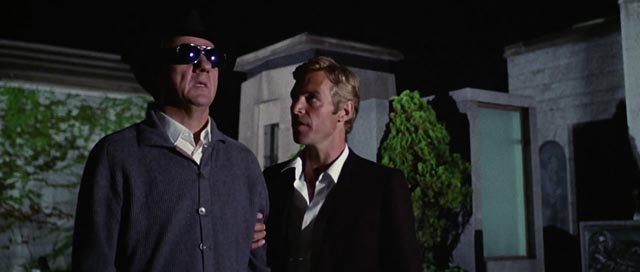
The Cat O’Nine Tails (Dario Argento, 1971)
Dario Argento’s films are generally very fluid and staged with a keen eye for composition and movement. Although his greatest success was with the fairytale horror of Suspiria, for the most part his work consists of thrillers – in fact, he pretty much defined the giallo as a genre, building on a handful of precursors by Mario Bava (The Girl Who Knew Too Much [1963], Blood and Black Lace [1964], 5 Dolls For an August Moon [1970] and A Bay of Blood [1971]). Argento’s thrillers are generally marked by an unseen killer (he uses POV camerawork extensively), a series of elaborately staged violent set-pieces, and occasionally a silly “high concept” gimmick to provide the plot motor. In Four Flies on Grey Velvet (1971), this was the old myth that the last thing seen by a murder victim is imprinted on their retinas; in the film a special camera is able to photograph that image, giving a clue to the killer’s identity. In his second feature, The Cat o’ Nine Tails (also 1971), it’s the idea that men with the genetic anomaly known as XYY chromosomes are inherently homicidal.
This film is perhaps the least interesting of Argento’s “animal trilogy” (which began with his first feature The Bird With the Crystal Plumage in 1970 and ended with Four Flies) and he himself calls it his least favourite because he went too far in a deliberate attempt to give the film an American look. In this respect it does seem less stylish than its two companions, but it does have one interesting if decidedly wacky element: Karl Malden as Franco Arno, a blind crossword puzzle creator who sets things in motion when he overhears a conversation one night between what turns out to be a blackmailer and a murderer; in this case the blind man can “see” things which the sighted characters remain oblivious of. Malden’s presence gives the film a gravity it would otherwise lack, and he’s well-supported by James Franciscus as reporter Carlo Giordani, whom he teams up with to solve the case. Although less innovative than The Bird With the Crystal Plumage, Argento directs the film with assurance, giving his characters a bit more personality than they sometimes have in his other movies, and overall it works well as a piece of slightly absurd pulp entertainment.
After completing the trilogy, Argento made a brief diversion into costume drama with Five Days in Milan (1973), then returned in 1975 with his giallo masterpiece Deep Red, after which he took that step into horror with Suspiria (1977); then for the next few years he alternated horror with gialli, following Suspiria with its companion Inferno (1980, as the first two parts of the Three Mothers trilogy) and five years later the hybrid Phenomena (1985). Arrow’s Blu-ray editions of these latter two offer excellent transfers and a variety of supplements (including a 50-minute making-of feature for Phenomena).
*
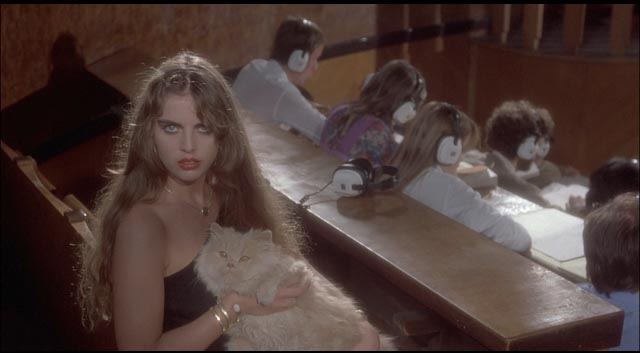
Inferno (Dario Argento, 1980)
The disregard for narrative logic and plausibility which marks many Italian horror and giallo films (and much of Asian horror as well) is what makes some people dismiss them, but others (myself included) find this aspect liberating. While these films do have their own rules and formulas, the feeling that they are unfettered by rationalism opens up all kinds of unpredictable possibilities. At their best, Argento’s fantasy-inflected films (starting with his other masterpiece, Suspiria), have a dreamlike quality which links them to the classic fairytale, narratives imbued with subconscious fears about the dangers of existence embodied in malevolent, personalized forces. (At their worst, they throw up absurdities like the giant praying mantis which Dracula turns himself into in the director’s awkward adaptation of Stoker’s novel.)
In Inferno, like Suspiria before it, this personified evil (whose motives remain undefined other than as a generalized malevolence) resides in a sinister building located in a city. (This trilogy – completed in 2007 with the much-derided Mother of Tears, which I consider one of Argento’s better later works – is loosely inspired by a reference in Thomas De Quincy’s Suspiria de Profundis [1845] to Our Ladies of Sorrow, three witches who control the world.) Once again the story begins with a young woman entering and beginning to investigate strange events in this building (a ballet school in Freiburg in Suspiria, an apartment building in New York in Inferno) as a series of strange and violent deaths overtake people around her. Structurally, Inferno is weaker than Suspiria: the apparent protagonist, Rose (Irene Miracle), a poet living in New York, actually dies quite early on, the narrative being taken up by her brother who flies in from Rome to investigate. Apart from the fact that Leigh McCloskey as Mark is a pretty dull presence, having a male protagonist dilutes the fairytale ambiance which seems stronger when a young woman faces off against the evil witch – obviously there’s a bit of gender bias in this impression, but it’s the vulnerability of Jessica Harper in Suspiria which gives added power to the threats confronting her, something missing in the bland McCloskey, but initially present with Miracle.
Like Suspiria, Inferno uses a richly saturated colour palette (heavily influenced by the work of Mario Bava, who incidentally worked in the camera and effects departments on Inferno – in fact, this was the final film to which he contributed his talents). Argento makes New York, particularly Central Park and its surroundings, look as magical and threatening as any fairytale landscape, and the film has several impressive set-pieces, most famously Rose’s descent into a flooded and decaying (and corpse-littered) ballroom beneath the apartment building; her subsequent pursuit and death; and the death of the antique seller next door who had originally sold her the book about the Three Mothers. In an appropriately fairytale-like demise, this man falls into a Central Park pond while drowning several cats and is overwhelmed by a huge pack of rats; while he struggles and screams under the assault, a nearby hotdog seller rushes towards him, we assume coming to the rescue, and abruptly stabs him to death with a huge knife. Inferno is best enjoyed as a collection of moments which never quite gel into a satisfying narrative whole.
*
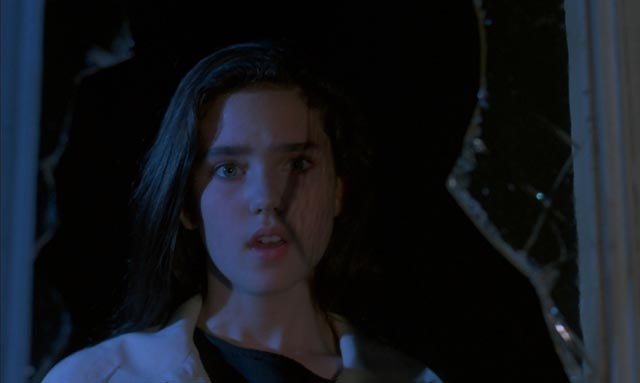
Phenomena (Dario Argento, 1985)
Argento retreated from the supernatural with his next film, the very chilly, formally impressive giallo Tenebrae; but following that he combined both strains of his work in Phenomena, a rather loopy giallo with supernatural elements. Like Suspiria, Phenomena centres on a young girl sent to a gloomy European boarding school, this time in Switzerland. Unhappy to be there, Jennifer Corvino (Jennifer Connelly), the daughter of a famous globe-trotting movie star, finds herself bullied by her fellow students and the rather nasty staff, while at the same time someone in the area is brutally killing girls. The mystery aspect is as arbitrary as usual (rooted in a past trauma which has left lingering physical and psychological traces); but grafted onto this is Jennifer’s psychic connection with (and ability to influence, even control) insects, an ability which eventually comes into play as she uses it to trace and expose the killer.
As in the animal trilogy, the absurdity of this gimmick is played straight – aided by Donald Pleasance’s presence as the crippled entomologist McGregor whom Jennifer allies herself with in solving the mystery; he gives his usual intensely committed performance, adding conviction and gravitas to the nonsense he’s required to speak. Connelly’s presence echoes Jessica Harper’s in Suspiria, vulnerable but brave, an outsider who is ultimately forced to deal with the menace alone; just fifteen at the time, she gives an impressively assured performance in only her second film (the previous year she’d played the younger version of Elizabeth McGovern’s character in Leone’s Once Upon a Time in America). Phenomena is atmospheric, with strong performances and visually impressive locations; it even has a chimp companion for the wheelchair-bound McGregor which plays a crucial role at several key moments in the story.
Phenomena and Argento’s next feature, Opera (1987), mark the end of his reign as Italy’s most successful director of thrillers; although there have been occasional moments of interest in his subsequent career, he never again managed to repeat the creative (and sometimes box office) success which he had maintained between 1970’s The Bird With the Crystal Plumage and Opera. Still, nine notable films in seventeen years is a pretty good record.
Next: even more from Arrow Video …
Comments